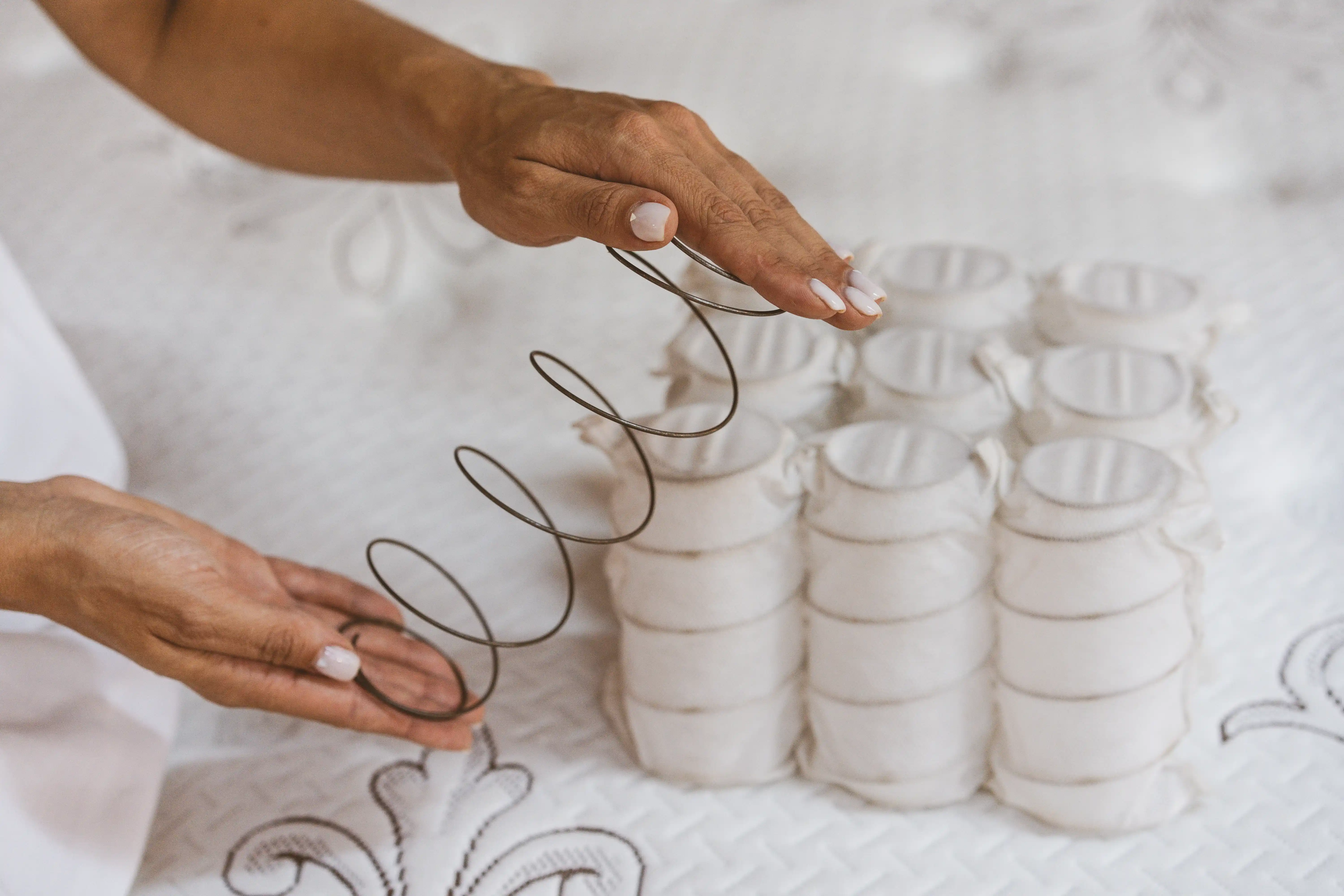Mattress coils form the backbone of support in most mattresses. These metal springs provide vital structural stability, creating a firm and reliable sleeping surface. When you lie down, the coils react to your pressure and movement by gradually flexing, offering progressive support that adjusts to your body's contours.

What Are Mattress Coils?
Mattress coils are usually constructed with tempered steel, To increase the coil's support and allow it to maintain its original form even after heavy use.
Depending on the coil type, gauge, total number of coils, and overall mattress design, coil-based mattresses can be more or less supportive.
Mattresses with coil construction are often responsive and long-lasting, compared to all-foam mattresses, coil mattresses are also a great fit for hot sleepers as they allow for ventilation.
What are Coil Count and Coil Gauge?
Coil count and Coil gauge are two of the main factors that impact the overall performance of coil mattresses and they should be considered based on your sleeping preference and style.
Coil Count
While coil count isn't the sole factor in support and comfort, it does play a role. Every mattress size has an ideal range, with generally at least 300 coils recommended for full-sized, 400 for queen, and 480 for king mattresses. In the queen-size realm, you'll find innerspring and hybrid options with coil counts ranging from 400 to 1,200. Remember, bigger isn't always better. Bonnell and offset coils are larger and come in lower counts, while pocketed coil systems typically pack more into smaller sizes.
Coil Gauge
Coil gauge in a mattress refers to the thickness of the wire used in its springs. It essentially tells you how firm the mattress will be. The typical range is 13 to 17 gauge, with 13 being the thickest and 17 being the thinnest.
Thicker, lower-gauge coils create a firmer, more supportive feel, while thinner, higher-gauge coils provide a softer, more responsive experience. Essentially, a higher gauge offers extra flexibility and bounce, while a lower gauge prioritizes sturdiness and stability.

Mattress Coil Types
Bonnell Coils
Bonnell coils, also known as hourglass coils, are wider at the top and bottom than in the middle, giving them their distinctive shape. This design allows the thinner midsection to flex under light pressure, providing excellent responsiveness and contouring. The wider ends, on the other hand, offer robust support for heavier loads.
While interconnected by metal helical wires, Bonnell coils function as a single unit. This delivers strong overall support, but unlike individually pocketed coils that adapt to each sleeper's body contour, Bonnell coils can feel slightly less conforming. Additionally, the metal connections can sometimes cause noise as the coils move together
| Coil Count: | 400 to 600 |
|---|---|
| Gauge Range: | Low to High |
| Pros | Affordable, Durable, and Responsive |
| Cons | Noisy, High-motion transfer levels, Prone to sagging, and Minimal flexibility |
Offset Coils
While similar in their hourglass shape, offset coils offer a significant bump in comfort and quietness compared to traditional Bonnell coils. This edge comes from their unique design. Instead of smooth curves, offset coils boast squared-off sides. This, combined with a connecting metal helical agent, creates an ergonomic form with two key benefits:
| Coil Count: | 500 to 2,000 |
|---|---|
| Gauge Range: | Medium to High |
| Pros | Supportive, Adaptable, and Low motion transfer |
| Cons | Costly, and Higher motion transfer than pocketed coils |
Continuous Wire Coils
Continuous coil mattresses, crafted from a single wire woven into rows of interconnected coils, stand out for their simplicity, sturdiness, and affordability.
Helical wires evenly distribute the coils within the frame, minimizing motion transfer, though pressure may still cause some movement compared to other technologies. While they can be slightly noisier than offset coils, their unmatched value proposition makes them a popular choice for budget-conscious sleepers.
| Coil Count: | 400 to 800 |
|---|---|
| Gauge Range: | Medium to High |
| Pros | Affordable, and Durable |
| Cons | Higher motion transfer, and minimal contouring |
Pocketed Coils
Pocketed coils offer two major benefits for sleepers: precise contouring and minimal motion transfer. Unlike a single unit, several smaller coils, individually wrapped in fabric, make up a pocketed coil mattress. This design allows each coil to react independently to pressure, conforming to your body's curves for exceptional support and comfort.
Additionally, movement on one side of the mattress is less likely to disrupt the other side, thanks to the isolated coils. This makes them a popular choice for couples seeking undisturbed sleep.
| Coil Count: | 800 to 1,200 |
|---|---|
| Gauge Range: | High |
| Pros | Adaptability, Minimal noise, and Minimal motion transfer |
| Cons | Expensive |
Microcoils, Nanocoils, and Minicoils
These small coils, most commonly found in the comfort or transition layers of mattresses, are designed with thin metal wires to improve a mattress's responsiveness, durability, and support.
Microcoils and small coils typically range from 1 to 3 inches tall, while regular innerspring coils stand around 6 inches.
Nanocoils take it a step further, with some measuring less than an inch in height. Providing additional contouring, most small coils are individually wrapped.
Their small size allows them to respond to pressure more quickly, creating a deeper cradling and quicker pressure relief for a balanced, supportive feel.
Which Mattress Types Have Coils?
Innerspring
Innerspring mattresses have a coil layer as a base support layer with a comfort layer of thin foam on top, which protects the sleeper from feeling discomfort from the coils.
People may easily move around on top of these mattresses since they often have a highly responsive and bouncy feel to them.
Hybrid
Although they often have larger comfort layers than innerspring mattresses, hybrid mattresses also feature coils at the bottom as a base support layer.
latex foam, memory foam, or other materials are used to create these comfort layers. The majority of them feel cool and breathable, and they provide an excellent mix of comfort and support.
FAQs
How Many Coils Should a Mattress Have?
The minimum recommended coil count varies from 300 for a full, 400 for a queen and 380 for a king. However, more coils don't always equal better comfort. Focus on quality materials and construction for a truly supportive sleep experience.
Are mattress coils noisy?
Yes, any mattress with coils may produce some noise to some degree, and as coil mattresses age, they often begin to creak and make louder noises, which might be a sign that it's time to acquire a new mattress.
Are coil mattresses better than foam?
It is entirely a matter of personal taste whether you will choose a foam mattress or a coil mattress.
Foam mattresses offer a luxurious, slow-moving sensation, but they are not as sturdy as coil mattresses which makes them more supportive, durable, and easier to move around on top of them.
Can you flip or rotate a coil mattress?
Flipping your mattress might prolong its life span, however, most modern mattresses are not designed to be flipped, so you should refer to the instructions that come with your mattress.
What Purpose Do Mattress Coils Serve?
Mattress coils are primarily designed to support your body and distribute weight uniformly. Steel coils, a component of innerspring and hybrid mattresses, aid in bed stabilization and maintain an equal plane for your spine.
What is better, a pocket coil or a continuous coil?
Pocketed coil is more popular because of its reduced motion transfer levels as each coil reacts to the pressure applied individually, however, pocketed coils tend to be on the pricier side, but continuous coil might have higher motion transfer levels, however, it’s much more affordable.
What do the numbers on a coil mean?
They refer to the resistance, and it’s measured in “Ohms” (Ω), A higher number usually means the coil is designed to allow less power through it, and most coils are between 0.15Ω - 2.1Ω.
Does a higher coil count mean a better mattress?
It's not always the case that mattresses with more coil springs inside of them are of better quality, but other factors determine the quality of the mattress, such as the materials used in the construction of the mattress.
How do I choose a coil?
Consider your budget and sleep preferences. If motion transfer is a concern, choose pocket coils. For affordability, continuous or Bonnell coils might be suitable.
Conclusion
Mattress coils are crucial to the overall support of hybrid and innerspring mattresses, forming the core of their structure. Their coil count and gauge have a considerable influence on how the mattress performs, so they deserve close attention when choosing your dream sleep surface.
From Bonnell to offset, continuous, and pocketed, each coil type boasts unique shapes, pros, and cons, directly affecting the mattress's feel and support. Making it a crucial factor to consider when choosing your perfect mattress.
Jessica H.
Jessica is a reviewer, writer, and sleep enthusiast at Sleepiverse. Jessica graduated with her master's degree in Nursing research and education. She is a registered nurse and currently works in the Intensive Care Unit. Since becoming a nurse, Jessica has worked the night shift, which means a disrupted sleep schedule. Knowing she needed to function at her best while caring for patients at night, she spent a lot of time researching how to sleep well with a difficult schedule.

